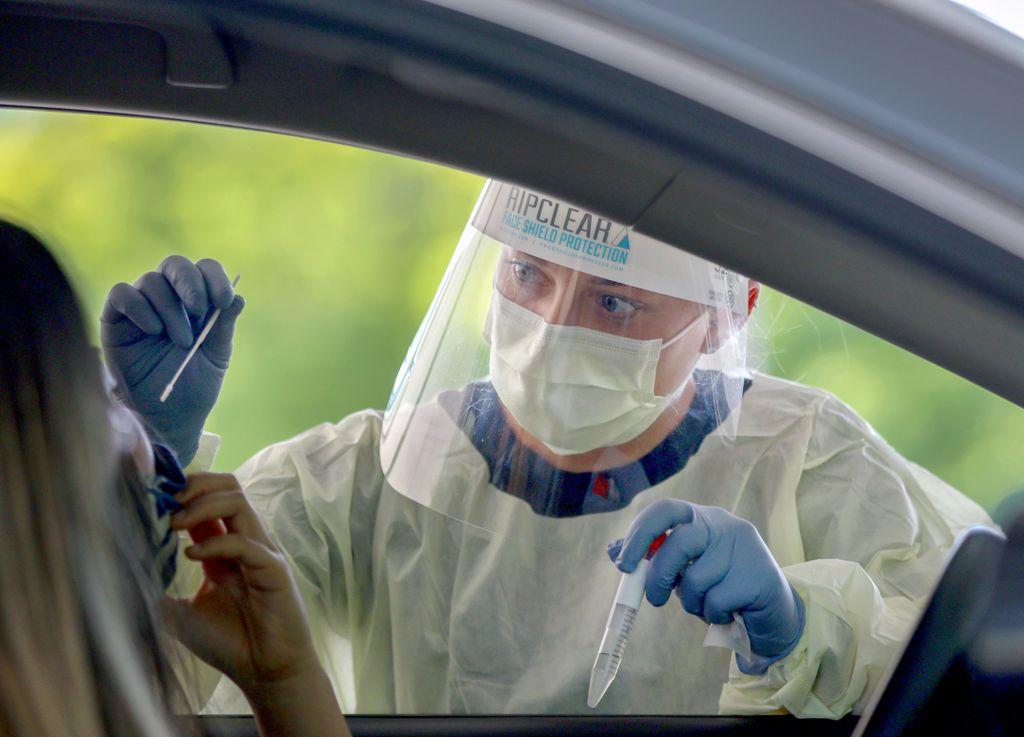
The number of Oregonians tested for coronavirus during historic wildfires is likely to plummet to levels not seen since this spring, a senior public health adviser said Monday, with the long-term impact of wildfires on the pandemic unclear.
The Oregon Health Authority reported preliminary data showing a 35% decrease in testing last week compared to initial figures from a week earlier.
As a result, Oregon may record fewer than 20,000 tests for the week ending Saturday. Officials expect similarly low numbers this week, too, as smoke from wildfires shuts down some testing locations and people with mild symptoms choose not to seek screenings.
The long-term consequences of the wildfires may not be seen in coronavirus cases for months. Officials are unsure if transmission will decrease, as more people stay inside, or increase among people displaced by fires and forced to live with others.
Public health leaders also worry exposure to hazardous air now could lead to more severe COVID-19 cases among people infected this fall.
“Of course this is a horrible time for historic wildfire,” said Dr. Melissa Sutton, a senior health adviser for the Oregon Health Authority. Sutton added that “it’s more important than ever to mask, to physically distance, to wash your hands, to avoid social gatherings.”
Sutton said people with coronavirus or smoke exposure may experience similar symptoms, including headache, sore throat, cough, trouble breathing or runny nose. Smoke exposure does not typically lead to fever or diarrhea, two symptoms associated with COVID-19.
Oregonians should not assume symptoms are caused by smoke, she said, and seek testing if necessary.
“Our guidance is that anyone with COVID-like symptoms should be tested for COVID-19, and we want them to seek appropriate medical care,” Sutton said.
Wildfires now add uncertainty to Oregon’s battle with the pandemic. The state had been making strong strides containing coronavirus, with average case counts down to about 185 a day -- not quite half the peak from July -- and positivity rates trending down for more than a month.
But much of the state is now blanketed in hazardous smoke from wildfires that have burned more than 1 million acres, including blazes in southern Oregon and the Cascade foothills beyond the Portland metro area. Resulting air quality has ranked among the worst in the world.
Oregon isn’t expected to see improvement in air quality until “late in the week,” said Gabriela Goldfarb, an environmental public health manager for the state. Fully 10% of recent emergency room visits across Oregon have been for asthma-like symptoms, she said.
Those wildfires have already reduced the number of Oregonians tested for coronavirus, according to preliminary statistics released Monday. Just 17,365 people provided test samples last week, although that number will increase as more results are reported to the state. The preliminary figures from the previous week were 26,855, eventually climbing by an additional 13%.
But even with an expected increase, the latest weekly testing totals are likely to at the lowest levels since May, when the state saw fewer than 21,500 tests.
“That is a substantial drop in testing, absolutely,” Sutton said.
The current week’s testing numbers may be similar. Some test-collection locations, such as two drive-up outdoor sites operated by OHSU, have shut down through at least Tuesday because of smoke. And even the Oregon State Public Health Laboratory, capable of processing hundreds of tests a day, has shut down because of hazardous indoor air quality.
“I’m not certain it would be lower,” Sutton said of this week’s testing totals. “But I do anticipate it would be similarly low. I think a lot depends on the weather.”
Reduced testing may also make it more difficult to keep tabs on the state’s progress in slowing the spread of COVID-19. Data from the state’s preliminary report Monday showed 5.6% of people tested last week had coronavirus – the highest rate since late July.
But some of that could be due to the sharp decrease in testing, with sick Oregonians still getting screened and skewing the percentages higher than otherwise, had more people been tested.
Sutton said officials will closely monitor the positivity rate with an eye on whether wildfire displacements leads to additional spread. She said transmission could go up or down, with the potential that smokey air keeps people home and fewer people get sick.
But there’s also concern about spread among people who have moved because of fires, particularly those in congregate settings such as prisons, she said.
“Anytime you bring new groups of people together, you have an increased risk of COVID transmissions,” she said.
Sutton said public health officials also worry that smoke inhalation now “could potentially increase the severity of COVID-19” among people who become infected. But, she cautioned, “we honestly don’t know” because so much is still being learned about the disease.
If anything, Sutton said, perhaps the wildfires can serve as a rallying point for Oregon. Sutton said politics has in some instances hindered public health interventions and she’s eager to see improvements.
“I’m also hopeful that these wildfires can bring us together,” she said, “and sort of refocus us on what we can do collectively.”
-- Brad Schmidt; [email protected]; 503-294-7628; @_brad_schmidt
This story was first published by The Oregonian/OregonLive and is posted here through an agreement among more than a dozen Oregon media outlets to share coronavirus coverage.